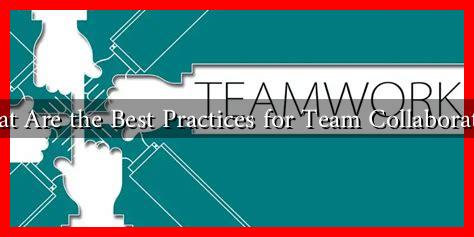-
Table of Contents
What Are the Best Practices for Team Collaboration?
In today’s fast-paced work environment, effective team collaboration is essential for achieving organizational goals and fostering innovation. As teams become more diverse and distributed, understanding the best practices for collaboration can significantly enhance productivity and morale. This article explores key strategies that can help teams work together more effectively.
Understanding Team Collaboration
Team collaboration refers to the process where individuals work together to achieve a common goal. It involves sharing knowledge, skills, and resources to enhance the overall performance of the team. According to a study by the Institute for Corporate Productivity, organizations that promote collaborative work environments are five times more likely to be high-performing.
Best Practices for Effective Team Collaboration
1. Establish Clear Goals and Roles
One of the foundational elements of successful collaboration is clarity. Teams should have well-defined goals and understand each member’s role in achieving them. This can be accomplished through:
- Setting SMART (Specific, Measurable, Achievable, Relevant, Time-bound) goals.
- Creating a RACI matrix (Responsible, Accountable, Consulted, Informed) to clarify roles.
- Regularly reviewing and adjusting goals as necessary.
For example, a marketing team launching a new product might set a goal to increase brand awareness by 30% within six months, assigning specific tasks to each member based on their expertise.
2. Foster Open Communication
Effective communication is the backbone of collaboration. Teams should encourage open dialogue and create an environment where members feel comfortable sharing ideas and feedback. Best practices include:
- Utilizing collaboration tools like Slack, Microsoft Teams, or Asana for real-time communication.
- Holding regular check-ins or stand-up meetings to discuss progress and challenges.
- Encouraging constructive feedback and active listening.
A case study from Google revealed that teams with high psychological safety—where members feel safe to take risks—are more innovative and productive.
3. Leverage Technology
In the digital age, technology plays a crucial role in facilitating collaboration. Teams should leverage various tools to streamline processes and enhance communication. Some effective tools include:
- Project Management Software: Tools like Trello or Monday.com help teams track tasks and deadlines.
- Document Sharing Platforms: Google Drive and Dropbox allow for easy sharing and collaboration on documents.
- Video Conferencing Tools: Zoom and Microsoft Teams enable face-to-face communication, which is vital for remote teams.
According to a report by McKinsey, productivity improves by 20-25% in organizations with connected employees, highlighting the importance of technology in collaboration.
4. Build Trust and Relationships
Trust is a critical component of effective teamwork. When team members trust each other, they are more likely to collaborate openly and share ideas. To build trust, teams can:
- Engage in team-building activities to strengthen relationships.
- Encourage transparency in decision-making processes.
- Recognize and celebrate individual and team achievements.
For instance, a software development team might hold regular social events or team retreats to foster camaraderie and trust among members.
5. Embrace Diversity and Inclusion
Diverse teams bring a variety of perspectives and ideas, which can lead to more innovative solutions. To embrace diversity, organizations should:
- Promote inclusive hiring practices to build diverse teams.
- Encourage diverse viewpoints during brainstorming sessions.
- Provide training on cultural competence and unconscious bias.
A study by Cloverpop found that inclusive teams make better business decisions 87% of the time, underscoring the value of diversity in collaboration.
Conclusion
Effective team collaboration is essential for success in any organization. By establishing clear goals, fostering open communication, leveraging technology, building trust, and embracing diversity, teams can enhance their collaborative efforts. As the workplace continues to evolve, adopting these best practices will not only improve productivity but also create a more engaged and innovative workforce. For further insights on team collaboration, consider exploring resources from the Forbes Human Resources Council.


